GIGABYTE G1.Sniper Z87 Review
by Ian Cutress on February 24, 2014 2:00 PM EST- Posted in
- Motherboards
- Intel
- Gigabyte
Scientific and Synthetic Benchmarks
2D to 3D Rendering – Agisoft PhotoScan v1.0: link
Agisoft Photoscan creates 3D models from 2D images, a process which is very computationally expensive. The algorithm is split into four distinct phases, and different phases of the model reconstruction require either fast memory, fast IPC, more cores, or even OpenCL compute devices to hand. Agisoft supplied us with a special version of the software to script the process, where we take 50 images of a stately home and convert it into a medium quality model. This benchmark typically takes around 15-20 minutes on a high end PC on the CPU alone, with GPUs reducing the time.
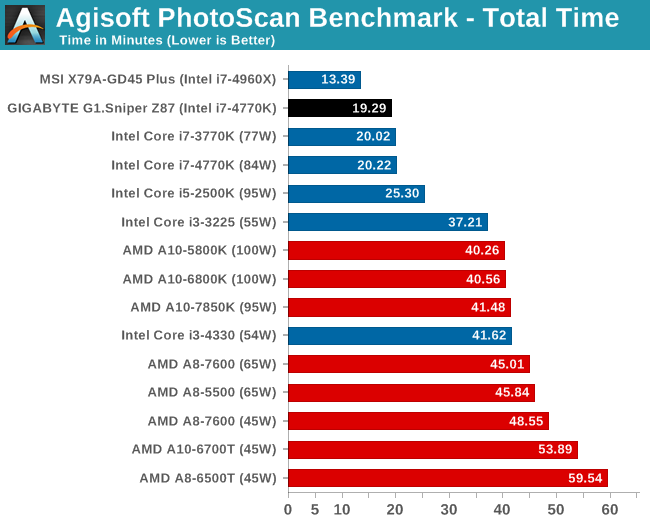
Console Emulation – Dolphin Benchmark: link
At the start of 2014 I was emailed with a link to a new emulation benchmark based on the Dolphin Emulator. The issue with emulators tends to be two-fold: game licensing and raw CPU power required for the emulation. As a result, many emulators are often bound by single thread CPU performance, and general reports tended to suggest that Haswell provided a significant post to emulator performance. This benchmark runs a Wii program that raytraces a complex 3D scene inside the Dolphin Wii emulator. Performance on this benchmark is a good proxy of the speed of Dolphin CPU emulation, which is an intensive single core task using most aspects of a CPU. Results are given in minutes, where the Wii itself scores 17.53; meaning that anything above this is faster than an actual Wii for processing Wii code, albeit emulated.
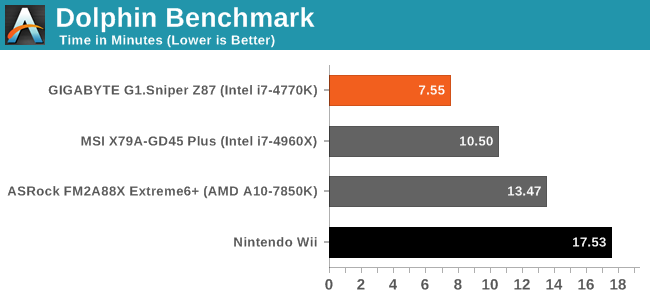
Haswell has been quoted as improving console emulation elsewhere on the web, and the results here give that quote substance.
Point Calculations – 3D Movement Algorithm Test: link
3DPM is a self-penned benchmark, taking basic 3D movement algorithms used in Brownian Motion simulations and testing them for speed. High floating point performance, MHz and IPC wins in the single thread version, whereas the multithread version has to handle the threads and loves more cores.
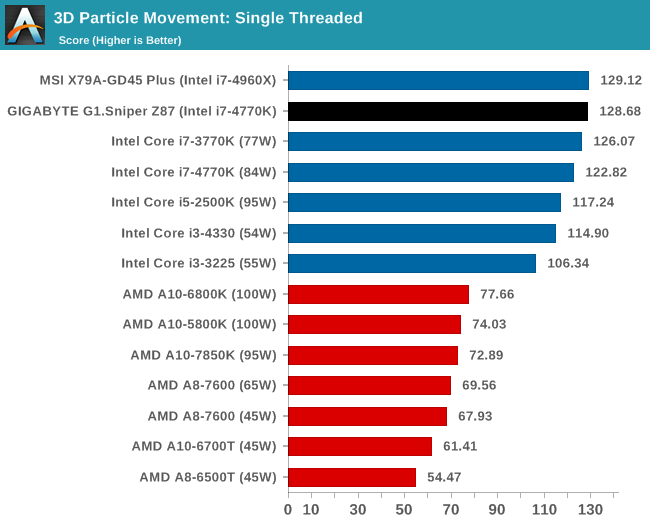 #
#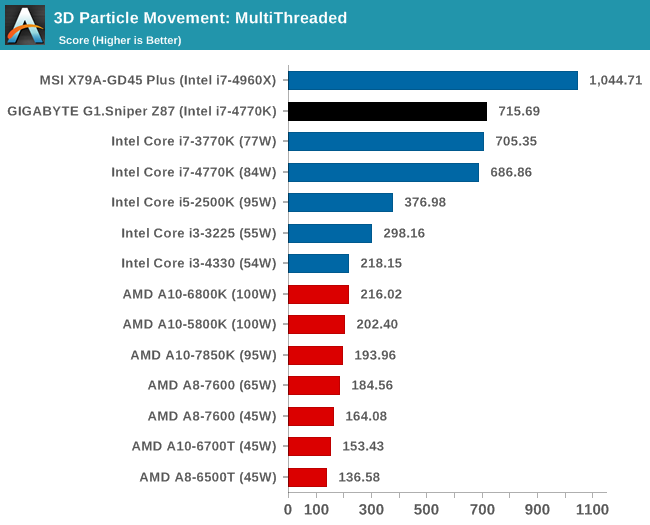
Encryption – TrueCrypt v0.7.1a: link
TrueCrypt is an off the shelf open source encoding tool for files and folders. For our test we run the benchmark mode using a 1GB buffer and take the mean result from AES encryption.
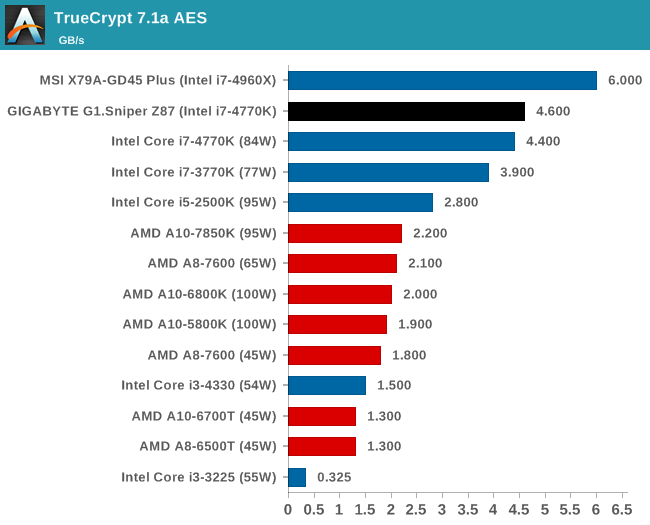
Synthetic – 7-Zip 9.2: link
As an open source compression tool, 7-Zip is a popular tool for making sets of files easier to handle and transfer. The software offers up its own benchmark, to which we report the result.
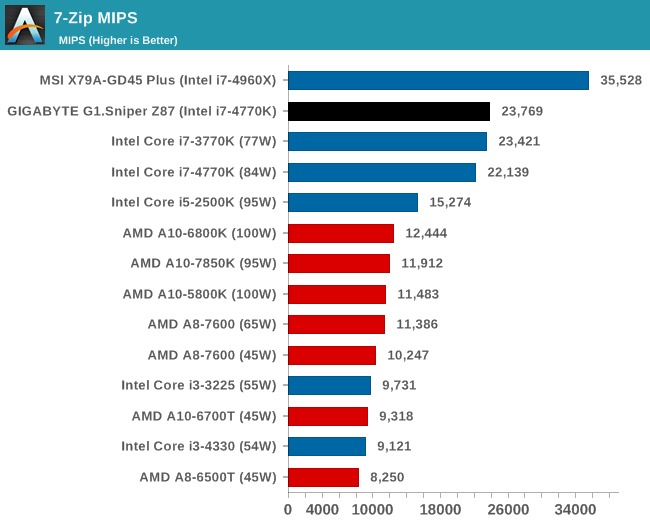










36 Comments
View All Comments
darthscsi - Monday, February 24, 2014 - link
I continue to wish MBs would put a pair of RCA ports for the front speakers rather than mess of 3.5mm connectors for 7.1. Optimize for the common (and most important) case.Flunk - Monday, February 24, 2014 - link
I don't think RCA are common at all.WithoutWeakness - Monday, February 24, 2014 - link
RCA isn't nearly as common as 3.5mm in a desktop environment and if someone is planning on running out to a receiver they should probably be using the optical or digital output anyway. Adding RCA outputs on top of those 2 options is unnecessary.Samus - Monday, February 24, 2014 - link
I actually agree with darthscsi. The market for this board is obvious, and with the attention given to audio performance, RCA would make a lot more sense than 7.1 3.5mm analog connections, especially when taking into account the swap-able OP-AMP is only for 2 channel stereo.Many T-AMP's from M-AUDIO, Dayton, Tripath, and so on, have RCA inputs that you annoyingly need to use a 3.5mm to RCA cable to connect. At a low level, 3.5mm is inferior to RCA at noise suppression while supporting shorter distance runs and less durability.
http://www.amazon.com/Dayton-Audio-DTA-100a-Class-...
MadMan007 - Monday, February 24, 2014 - link
If you really care about audio you'll only use the onboard audio as a digital transport with an external DAC.Sancus - Monday, February 24, 2014 - link
What would you use RCA for? If you have a serious audio setup, you'll have a separate receiver/amplifier and you definitely don't want to be using the DAC in the motherboard in that case, you'll either want digital out to the receiver directly, or digital out a separate, high-end DAC.If you have a standard self-amplified desktop speaker setup, you'll have 3.5mm inputs, not RCA.
Samus - Monday, February 24, 2014 - link
The whole point of this motherboards fancy Creative chip is that it has a superior DAC to most sub-$500 receivers. If you have a $3500 Denon, that's a different story...Frolictoo - Sunday, March 2, 2014 - link
Consider trying out the MAYA44 XTe sound card. You may be pleasantly surprised by the many options offered. The Xte is a professional level sound card and there are many reviews on it.blackmagnum - Monday, February 24, 2014 - link
Listening to music on an onboard sound device is like playing a game using an onboard video card: while possible, it's not enjoyable.baal80 - Monday, February 24, 2014 - link
Really? I've been using onboard sound since my last Sound Blaster Pro and I really don't see the point in buying a discrete sound card (for casual gaming/using). To each his own, I guess!